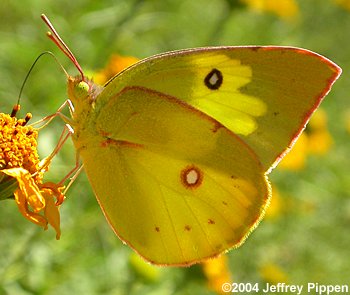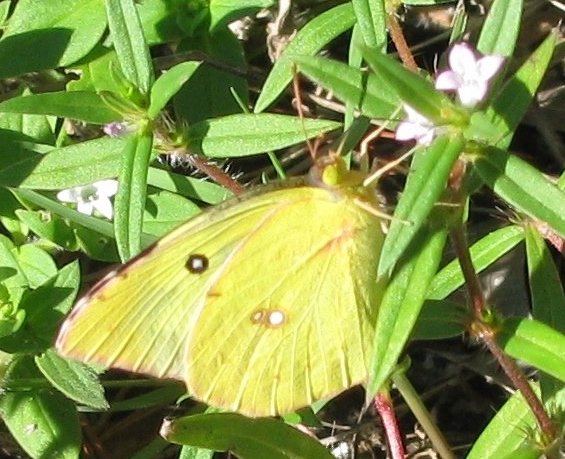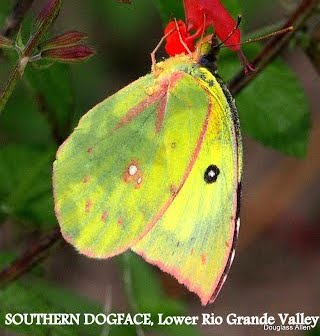|
| Common Name | Southern Dogface by Jeff Pippen => Hidalgo Co., TX
15 Oct 2005
[View PDF]
 Click to enlarge Click to enlarge
[Google Images] GBIF [Global Distribution ] BoA [Images ] iNaturalist |
| Scientific Name | Zerene cesonia
|
| Link to BAMONA species account. |
| Map | Click on a county for list of all database records for the species in that county.
 |
| Distribution | DISTRIBUTION: A declining stray; scattered records in all three provinces, but mainly from the southern half of the state. In 2019-21, a few have been seen in the warmer months only a few miles south of the state in Chesterfield County, SC; as they were in suitable breeding habitat in the Sandhills, some ovipositing might have occurred. Thus, in NC it is most likely to be looked for in the Sandhills close to the SC state line (e.g., Richmond or Scotland counties). As this region gets considerable butterfly coverage during the year, the species is not being overlooked and any report should be considered as a wandering individual.
|
| Abundance | ABUNDANCE: A very rare and erratic migrant from the South and Southwest. Irregular from year to year, with the species seldom reported in recent decades. Certainly more numerous or regular formerly. We are aware of just five state reports since 1990: one seen nectaring at Weymouth Woods Sandhills Nature Preserve in Moore County on November 2, 2001 by Scott Hartley; one seen in flight in Brunswick County in mid-August 2003 by John Dole; one seen nectaring at Jordan Lake in Chatham County on November 13, 2005 by Greg Schneider and Brock Martin; one seen perched at Riverbend Park in Catawba County on October 13, 2008 by Lori Owenby; and one seen in flight at Raleigh in Wake County on October 25, 2012 by Mike Turner. Though there are certainly old specimens, we are not aware of any photographic documentation of a Southern Dogface from the state.
|
| Flight | FLIGHT PERIOD: Not known in NC; several broods in the Deep South, scattered over most of the year. As most "out of range" visitors appear in late summer and fall, it is expected to be seen mainly from July or August onward. However, there were a number of records from Fort Bragg (now named as Fort Liberty) from April to June several decades ago (fide Richard Anderson).
|
| Habitat | HABITAT: Relatively open brushy areas, such as weedy fields, cut-over areas, and woodland borders. Unlike most southern strays, it is not likely around gardens, cultivated areas, and other human habitation. The typical habitat in Florida is mostly dry pine scrublands, as are most of the recent records from South Carolina (i.e., Longleaf Pine sandhills).
|
| Plants | FOOD AND NECTAR PLANTS: Legumes are the primary foodplants, though this is irrelevant in NC. Nectar plants in the state are not known.
|
| Comments | COMMENTS: Richard Anderson had six records from the Fort Liberty area in the Sandhills, from April to June, suggesting possible residency in that area, as strays from the South typically do not appear until later in summer and fall. Not surprisingly, the species has been found much more often in SC (25 counties, which is 54% of the state's counties) than in NC. Some recent records there are for spring or summer, and it appears to be a rare resident in the southern part of the SC Coastal Plain; a few were seen in 2019-21 in sandhills habitats in Chesterfield County, within a few miles of NC. Numbers into the dozens have been recorded in summer and fall 2022-23 at the Wateree Heritage Preserve in Richland County, SC, in the north-central part of the state; it certainly is breeding there. Identification is relatively easy, even in flight; thus, it is not likely to be overlooked, especially as the Clouded Sulphur is very rare in much of the area where the Southern Dogface might be expected.
NOTE: A colony of Southern Dogfaces was found in 2001 in southeastern VA. Though one might think this suggests a major flight into VA in 2001, lack of data from the Carolinas rules out such a flight. Instead, a gravid female likely reached VA during the year and produced a new generation (assuming a suitable food plant was present).
|
State Rank | SZN | | State Status | |
Global Rank | G5 | | Federal Status | |
| Synonym | Colias cesonia
|
| Other Name |
|
|
|

 >>
>>

